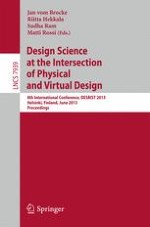2013 | Buch
Design Science at the Intersection of Physical and Virtual Design
8th International Conference, DESRIST 2013, Helsinki, Finland, June 11-12, 2013. Proceedings
herausgegeben von: Jan vom Brocke, Riitta Hekkala, Sudha Ram, Matti Rossi
Verlag: Springer Berlin Heidelberg
Buchreihe : Lecture Notes in Computer Science
